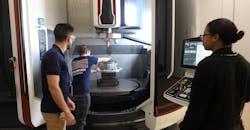Pratt & Whitney is planning a $20-million investment at its West Palm Beach, Fla., Engine Center to increase maintenance, repair and overhaul (MRO) capacity for its GTF commercial aircraft engines. The expansion is seen adding 40% more capacity for engine service and repair, and is expected to be complete by the second half of 2025.
Included in the new capacity will be some “transformative technologies” Pratt & Whitney has developed at its North American Technology Accelerator, at the same location.
The engine builder will expand the workforce at the West Palm Beach operation by 25% over the next year, with positions in machining, testing, cleaning, and warehousing.
Pratt & Whitney’s GTF (or geared turbofan) engine is a high-bypass engine officially designated as the PW1000G series and offered in different size variants (PW1100G, PW1200G, PW1400G, PW1500G, PW1700G, PW1900G), and installed in the Airbus A220 and A32neo and Embraer E-Jet E2 narrow-body jets.
The West Palm Beach operation was updated to a fully capable GTF MRO engine center in 2021, and was Pratt & Whitney’s first location to adopt an automated system for assembling high-pressure compressor (HPC) rotors and a refined overhead engine handling system. Since that time, Pratt & Whitney notes it has recorded more than a 25% improvement in HPC rotor yield and a 50% reduction in process turnaround time.
The North American Technology Accelerator (NATA) is a new development at West Palm Beach, announced as a $20-million update to the MRO operation that will create a commercial and military aftermarket operations “center of excellence.” P&W has concentrated research and development expertise there for automation, connectivity, analytics, and intelligence capabilities, to benefit aftermarket operations.
Complementing the group’s Singapore Technology Accelerator, the NATA will have dedicated floor space, equipment and resources for developing and industrializing “technology insertion” programs that will support the company's global maintenance, repair and overhaul (MRO) network. The Florida center’s accelerator projects are focused on material restoration and process automation, including advanced repairs, digital inspection, adaptive processing, and coating and masking for compressor and fan parts, blades, cases, etc. These technologies are seen reducing cost, material demand, and environmental impact, while decreasing turn times, improving throughput, and delivering value to customers, according to Pratt & Whitney.
Some exemplary projects will be additive-manufacturing repairs for critical GTF engine components, Pratt & Whitney expects will recover $100 million worth of parts over the next five years.
"NATA combines data science with people know-how and state-of-the-art automation to help address customer pain points such as inventory management and part availability, while accelerating our improved repair capabilities and efficiency to better serve our customers," stated Kevin Kirkpatrick, vice president, Aftermarket Global Operations at Pratt & Whitney.
About the Author
Robert Brooks
Content Director
Robert Brooks has been a business-to-business reporter, writer, editor, and columnist for more than 20 years, specializing in the primary metal and basic manufacturing industries.
